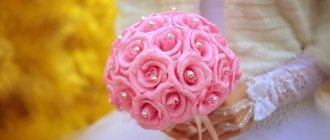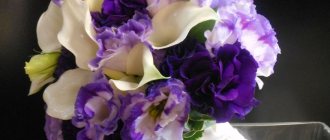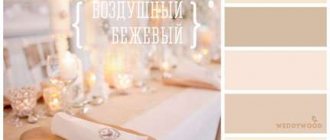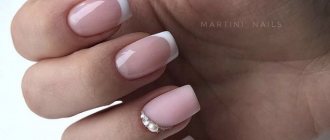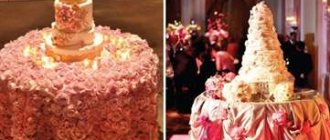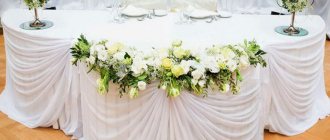The pre-wedding days are filled with pleasant chores and important matters. You need to take care of the venue for the celebration, choose beautiful outfits for the bride and groom, and create charming flower arrangements. A lot of worries are associated with choosing a wedding bouquet.
The attribute should match the style of the wedding and set off the bride’s outfit. Any large-scale celebration or holiday with the family is not complete without a charming bouquet. Basically, fresh flowers are used to make it. However, modern brides are increasingly giving preference to artificial materials for creating wedding compositions. One of these materials is foamiran.
Products made from such raw materials do not cause allergies, retain their attractive appearance for a long time, and do not deteriorate when exposed to cold temperatures. A bride's bouquet made from foamiran can be an excellent addition to your home interior after the wedding.
Floristry from foamiran
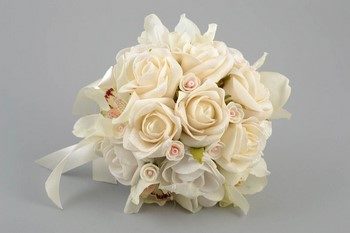
Often the bride simply cannot afford real flowers. For example, she wants a certain variety that is simply not in season to grow at the moment. In such cases, florists suggest immediately choosing another plant.
But the young lady thought through all the options in advance and decided that this rare look would be ideal for her. It is worth noting that the bride should not give up her desires so quickly and quickly.
As an example, we can take another situation. The girl has many allergies, including to flowers. When the wedding approaches, she realizes that she simply is not able to take the bouquet with her. He will intoxicate her and spoil her health.
Such brides should not give up floral accessories altogether; they can use a trick by replacing real plants with artificial ones. This move will allow the bride to preserve the tradition and go to the wedding with a bouquet. The floristry made from foamiran is amazing.
It has a lot of advantages that distinguish it from real flowers:
- They retain their appearance for a long time - this is an undeniable plus, which can be called the main one. Foamiran is an artificial material that can stand in its original form for several decades. If you don’t touch the handmade bouquet, it will delight your family for a very long time. After the wedding celebration, brides are perplexed, racking their brains over what to do with the bouquet. And many people are very sorry to throw it away. As a rule, a composition of fresh flowers stands in a vase until it finally fades, when its petals fall onto the table. Only after this the young lady decides that it is better to throw the bouquet away.
- Allergy sufferers do not have to worry, since foamiran does not have any odor. Accordingly, it does not affect health and can be safely used by even the most severe asthmatics.
- Handmade products have always attracted attention. It seems to be imbued with special energy and warmth. Your accessory will become especially valuable if you manage to make it yourself.
A rich color palette, a variety of plant species - all these are undeniable advantages for which brides choose foamiran as the main material for their wedding bouquets.
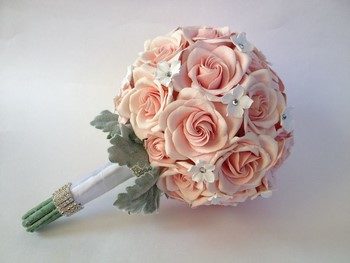
Foamiran for a wedding.
Miracle material
Foamiran (abbreviated as foam or fom) is a soft synthetic material with a porous structure, which is produced in the form of sheets (rolls) and is successfully used in various types of needlework. The name comes from the English word foam - “foam” and from the name of the homeland of this material - Iran. It is also produced in China, but the quality differs somewhat. On the Internet and in stores you can also find the following names: foamed or porous rubber, foam material, plastic (artificial) suede, revelour. Abroad, the material is known as foam eva - short for “foamed ethylene vinyl acetate”.
The fact that the composition includes ethylene and vinyl acetate ensures the elasticity and strength of the material. Foam is much stronger than ordinary paper, holds its shape perfectly and at the same time it is soft and pleasant to the touch. To produce the foam mass, from which spongy sheets of foamiran are then obtained, special automatic equipment is used. Thanks to a special production technology, the colors of the material remain saturated even over time. By the way, fom is available in both bright rich colors and delicate pastel shades. And the sheets can be additionally painted.
Foamiran is non-toxic and harmless to the environment. The specific smell of a new roll disappears quite quickly after opening the package. Products made from plastic suede are not afraid of temperature changes, exposure to moisture, dirt and mechanical compression, that is, they do not get dirty or wrinkle. Therefore, they can be used for decoration both indoors and outdoors, and they can even be washed.
The main feature of the foam is its ability to stretch slightly - up to 10%. This is enough for the material to take on and “remember” a new shape. Plastic suede molds well when exposed to the heat of human hands and electrical appliances (an iron is usually used for heating).
Options for bouquets made of foamiran
The most popular flowers made from foamiran are roses and peonies. These are those products that, with proper work and a careful approach, are quite difficult to distinguish from real flowers.
In the case of a wedding accessory, two scenarios are possible. According to the first, a girl can make a bouquet on her own.
To do this, she will need to purchase all the necessary goods and be patient. If you have no desire to do something yourself, then you can always order it from a professional.
- Foamiran roses - a distinctive feature of such flowers will be a rich assortment of color palettes. For summer celebrations, florists advise choosing light shades; for winter celebrations, deeper and richer tones are preferred. In order to make a rose, you need to take a piece of paper and cut out a so-called blank from it. This will be a template that can then be easily applied to the foamiran itself. Using the template, you will be able to cut out several absolutely identical petals. Don't worry about the mounting method. Heat the iron well and run it at the base of the workpiece. Glue several petals together to form a bud. Everything must be done quickly, before the foamiran has cooled down. The material can be molded, so you can easily make a full-fledged rosebud from it.
- Foamiran peonies are a much more complex plant that will require experience. Peonies must be made according to the same principle as roses. However, each flower petal should be twisted in such a way as to create a light wave. Using glue, collect the peony petals and connect them at the base.
Petal by petal
Of course, such a miracle material simply could not go unnoticed by creative people, because this is a real find for lovers of handicrafts. It began to be used for various applications, scrapbooking elements, three-dimensional crafts and toys. But the most spectacular and realistic flowers are made from foamiran. High-quality buds look as if they were alive - you want to touch the delicate petals and breathe in their aroma. But for the flowers to turn out so natural, we need not only our magical material, but also special tools, as well as certain skills in working with it.
From foamiran you can make almost any flower - from a simple chamomile to an exotic orchid. First, let's try to create the queen of flowers - a classic rose. To work, we will need material of two tones - pink (for petals) and green (for leaves).
To cut out petals, you can use special machines, shaped composters or metal cutters (from the English cut - cut), which give the petals an almost ideal shape. But in the absence of such, it is quite possible to get by with ordinary scissors. We cut a long strip from a sheet of foamiran and cut it into squares approximately 3-4 cm in size. We will need about 20-30 of them. We put the squares in stacks of 5-6 pieces and cut out the petals: round the corners, give them a teardrop shape.
Foamiran, as we have already noted, can be additionally painted - with oil pastels (regular dry ones crumble quickly) or acrylic. This gives artificial petals a greater resemblance to natural ones. So, put the petal on a sheet of paper and lightly go over the edges with pastel. If the lines turn out to be sharp and too bright, they can be “blurred” by shading them with a soft foam sponge. We tint each petal on both sides. By the way, when painting a base of the same color with different shades of pastel and with different intensities, you can end up with completely different results.
Now that we have a bunch of “toasted” blanks, we need to give them the texture of rose petals. This can be done in different ways. Here is one of the most affordable ones, which does not require any additional tools other than an iron. We turn on the latter and warm it up properly. We briefly apply each petal to the iron and, when it warms up, quickly and carefully fold it and begin to twist. You need to press hard enough, but keep in mind: excessive tension can lead to the part breaking.
Now unfold the petal and press a small depression in the center with your finger. We leave some of the petals in this form: they will be useful to us for forming the core of the bud (two such petals per bud). And with the rest we proceed as follows. Once again we apply them with the edges to the iron and slightly round them on the sides.
Another way to recreate the texture of real petals is to use molds. A mold is an imprint of the structure of a petal or leaf of a flower. A petal cut from foamiran and heated on an iron is placed on the mold, and it leaves an imprint on it. Different molds allow you to create imitations of a wide variety of plants and flowers. Thanks to them, the finished products are more accurate and similar to living plants, and the process of creating them goes much faster.
And now we move on to the most interesting, but also the most difficult part of the work - the formation of the bud. For this we need a glue gun. Also, parts made of plastic suede are glued together using a special glue for foamiran, moment-gel or any other strong-holding glue.
To assemble a three-dimensional flower, you can use a small ball or a wire base to which the petals are glued. And you can do without it. We take the first petal - one of those with non-rounded edges - apply a thin strip of glue in the middle (across) and carefully twist it. Take the second petal, apply glue just below the middle and wrap it around the first one. We apply the next petals (with rounded edges) with an offset: the edge of each new petal should coincide with the center of the previous one.
So, petal by petal, we form a bud. They should all be at the same height and fit fairly tightly to each other. But do not pull them too tightly so that the rose turns out lush and open. For a small rose (spray type) 6-8 petals are enough, but for a larger one you may need up to 30 pieces.
Now let's take care of the leaves. We cut them out of a green sheet of foamiran. Using manicure scissors, we make notches along the edges of each workpiece. The leaves can also be slightly tinted with pastels. Now we heat them one by one and apply them to the mold, which conveys the entire texture of a real sheet.
The final touch is the green “antennae”. We cut out elongated triangles from the same green foamiran. We fold them in pieces of 5, apply them to the iron and, while they are heated, twist them.
Now we collect all the elements into a single composition. Glue 3-4 antennae to two small buds. We connect them with each other. We cut off the lower part a little diagonally with scissors. Glue it to the big rose. We fix the leaves in a circle and supplement them with tendrils. To cover the unsightly underside (the place where the parts meet), you can glue a circle cut from the same foamiran, a wire stem or fastening fittings to the back - it all depends on the quality in which this mini-composition will be used.

DIY foamiran decor
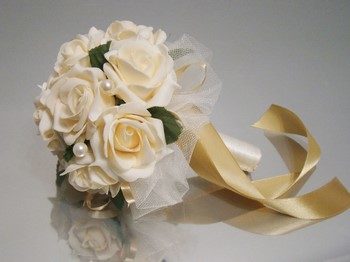
Don't forget not only the bride's bouquet, but also the groom's boutonnieres. Unfortunately, not everyone has the same boutonniere and bouquet. This is one of the main mistakes.
They must be made of a single material, which will create the integrity of the picture. For a young man, the boutonniere should also be made from foamiran, which will look harmonious with the groom’s overall image.
As an additional decorative element from foamiran you can make:
- decorations for each table;
- bridesmaid bracelets;
- decorative hairpins;
- flower table.
In the end, the bride, if she wishes, can make one beautiful rose and give it to each guest at the end of the evening as a sign of gratitude and appreciation. This will mean that the newlyweds are glad that they have such friends and relatives who came to share such a bright and joyful day with them. DIY wedding bouquets from foamiran:
